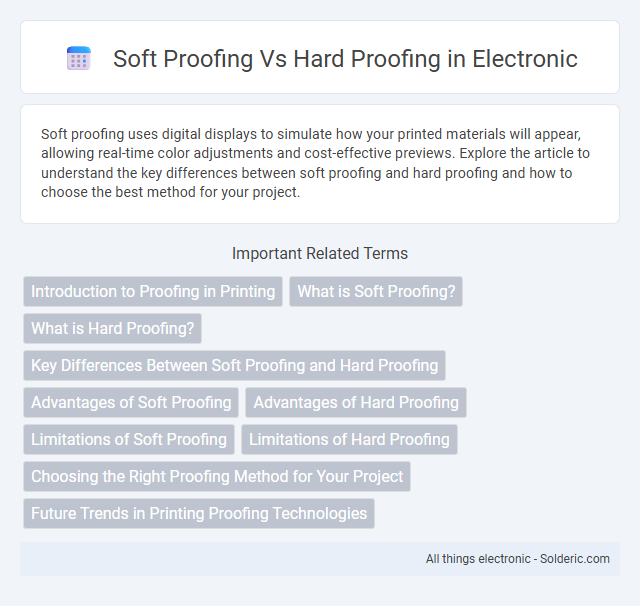Soft proofing uses digital displays to simulate how your printed materials will appear, allowing real-time color adjustments and cost-effective previews. Explore the article to understand the key differences between soft proofing and hard proofing and how to choose the best method for your project.
Comparison Table
| Aspect | Soft Proofing | Hard Proofing |
|---|---|---|
| Definition | Digital simulation of print output on a monitor | Physical printed sample representing final output |
| Medium | Computer screen | Printed paper or substrate |
| Accuracy | Good color accuracy with calibrated display | Highest color and detail accuracy |
| Cost | Low cost, no printing required | Higher cost due to physical print production |
| Speed | Instant preview | Requires print production time |
| Use Case | Preliminary approvals, on-screen color checks | Final approval before mass printing |
| Limitations | Dependent on monitor calibration and lighting | Consumes materials and time |
Introduction to Proofing in Printing
Soft proofing uses digital displays to simulate the final printed output's colors and details, enabling efficient and cost-effective review before physical production. Hard proofing involves creating physical samples using the actual printing materials and processes, ensuring accurate color fidelity and tactile quality assessment. Both methods are essential in printing to minimize errors, optimize color accuracy, and confirm final output before full-scale production.
What is Soft Proofing?
Soft proofing is a digital technique that allows you to preview how your images or documents will appear when printed by simulating print colors onscreen. It uses color profiles and calibrated monitors to replicate the output device's color gamut and tone, helping to identify and correct potential color issues before producing a physical proof. This process saves time and resources by reducing the need for multiple print iterations and ensuring your final print matches your visual expectations.
What is Hard Proofing?
Hard proofing is the process of creating a physical print sample to accurately represent the final output of a digital design before mass production. It involves using calibrated printers and specific substrates to ensure color fidelity, resolution, and material attributes closely match the intended print job. This method provides a tangible proof for quality control, allowing adjustments to be made to avoid costly errors in the final print run.
Key Differences Between Soft Proofing and Hard Proofing
Soft proofing uses digital displays to simulate how colors will appear in the final print, allowing quick and cost-effective adjustments to your designs. Hard proofing involves creating physical samples with printers, providing an accurate representation of colors, paper texture, and finish that digital screens cannot fully replicate. Understanding these key differences helps you choose the right proofing method to ensure color accuracy and quality control in your printing workflow.
Advantages of Soft Proofing
Soft proofing offers real-time color accuracy by simulating printed output on calibrated monitors, reducing the need for physical proofs and saving costs. It accelerates the revision process, allowing you to make precise adjustments quickly before final printing. Digital proofing also minimizes environmental impact by cutting down on paper waste and resource use.
Advantages of Hard Proofing
Hard proofing offers tangible color accuracy by producing physical prints that closely match final production output, reducing the risk of color discrepancies. This method allows you to evaluate paper texture, weight, and finish, ensuring quality control before mass printing. Hard proofs provide reliable and consistent results, making them essential for precise color management in professional printing workflows.
Limitations of Soft Proofing
Soft proofing limitations include color accuracy issues due to monitor calibration inconsistencies and ambient lighting variations, which can affect how colors are perceived on-screen. Unlike hard proofing, soft proofing cannot replicate the final print's texture, finish, or substrate characteristics, leading to potential discrepancies in print quality expectations. Your reliance on soft proofing requires understanding these constraints to prevent color mismatches and ensure better print results.
Limitations of Hard Proofing
Hard proofing faces limitations such as color inaccuracies due to variations in printing substrates and ink formulations, which may not perfectly replicate final output colors. It often requires more time and material costs compared to digital soft proofing, slowing down the production process. Limited adaptability to quick changes also reduces its efficiency for iterative design reviews and approvals.
Choosing the Right Proofing Method for Your Project
Soft proofing offers digital accuracy and cost-efficiency by simulating color and layout on calibrated monitors, ideal for early-stage design revisions. Hard proofing provides tangible, high-fidelity print samples, crucial for final approvals where precise color matching and material texture validation are essential. Selecting the right proofing method depends on project requirements, budget constraints, and desired accuracy level in color reproduction and finish.
Future Trends in Printing Proofing Technologies
Future trends in printing proofing technologies emphasize the integration of AI-driven color accuracy tools and real-time cloud collaboration platforms, which enhance the precision and efficiency of both soft and hard proofing processes. Soft proofing continues to evolve with augmented reality (AR) and advanced color calibration software, allowing Your team to visualize print outcomes on various devices before production. Meanwhile, hard proofing benefits from eco-friendly materials and high-resolution inkjet advancements, ensuring sustainable and ultra-realistic physical proofs that meet increasing industry standards.
Soft proofing vs Hard proofing Infographic

 solderic.com
solderic.com